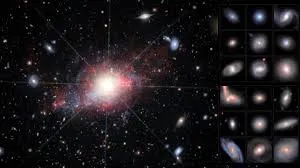A groundbreaking discovery in astrophysics has revealed the largest collection of intermediate-mass black holes ever found. Scientists, using data from the Dark Energy Spectroscopic Instrument (DESI), identified 300 intermediate-mass black holes in dwarf galaxies, tripling the previously known count. This discovery could transform our understanding of black hole evolution and galaxy formation.
Findings Published in The Astrophysical Journal
The research, published in The Astrophysical Journal, highlights that 2,500 dwarf galaxies host active black holes, far more than previously estimated. Ragadeepika Pucha, a researcher at the University of Utah and lead author of the study, explained that when black holes consume surrounding material, they emit energy detectable by astronomers. These emissions reveal hidden black holes in smaller galaxies, known as active galactic nuclei (AGN).
The Nature of Intermediate-Mass Black Holes
Intermediate-mass black holes are crucial to understanding black hole evolution. They fall between stellar-mass black holes (up to 1,000 times the mass of the Sun) and supermassive black holes (millions or billions of times the Sun’s mass). These black holes are thought to be remnants of the first black holes formed in the universe, acting as a bridge in the transition from smaller black holes to supermassive ones.
DESI’s Role in Identifying Hidden Black Holes
The DESI instrument, mounted on the Nicholas U. Mayall 4-meter Telescope at Kitt Peak National Observatory, played a vital role in this discovery. Capable of capturing light from 5,000 galaxies at once, DESI provided unprecedented data on 410,000 galaxies, including 115,000 dwarf galaxies.
From this dataset, researchers identified 2,500 dwarf galaxies with active galactic nuclei, significantly more than previous studies had estimated. Additionally, they confirmed 300 intermediate-mass black holes, suggesting that many similar low-mass black holes have been overlooked in past research.
Implications for Black Hole Evolution
This discovery challenges existing theories on black hole growth and suggests that dwarf galaxies may play a more significant role in the formation of supermassive black holes than previously believed. By studying these intermediate-mass black holes, astronomers hope to uncover how black holes grow and evolve over time.
With continued observations from DESI, researchers anticipate even more breakthroughs in understanding black hole formation and cosmic evolution.























